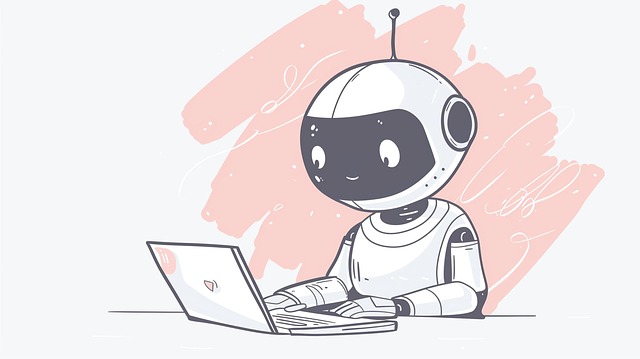Chatbot AI, powered by natural language processing (NLP) and machine learning, transforms customer engagement and operational efficiency. These virtual assistants automate text-based conversations, handling repetitive tasks while allowing human resources to focus on complex interactions. Scripted AI chatbots use NLP to understand user inputs and generate contextually appropriate responses through carefully crafted conversation flows. Strategic design and compelling scripts ensure seamless, engaging interactions. Training involves acquiring high-quality data, selecting suitable machine learning models, fine-tuning, and deploying the model in a chatbot interface. Continuous improvement through testing, iteration, and user feedback is crucial for maintaining chatbot AI's relevance and effectiveness.
Creating a scripted AI chatbot is an exciting way to enhance customer engagement and automate interactions. In this article, we’ll guide you through the process of building your own, from understanding the fundamentals of chatbot AI to crafting sophisticated scripts. We’ll explore key components, conversation design, training models, and continuous improvement techniques. By the end, you’ll be equipped with the knowledge to develop intelligent, effective chatbot ai solutions tailored to your needs.
- Understanding Chatbot AI: Defining and Purpose
- Components of a Scripted Chatbot System
- Designing the Conversation Flow and Scripts
- Training and Implementing the AI Model
- Testing, Iteration, and Continuous Improvement
Understanding Chatbot AI: Defining and Purpose

Chatbot AI, or artificial intelligence designed for conversational interactions, is rapidly transforming how businesses engage with customers and streamline operations. At its core, a chatbot AI serves to automate text-based conversations, leveraging natural language processing (NLP) and machine learning algorithms to comprehend user inputs and generate appropriate responses.
The purpose of these virtual assistants extends beyond simple customer service. They can act as sales representatives, providing product recommendations; as support agents, troubleshooting issues; or even as personal assistants, managing schedules and tasks. By understanding user intent and context, chatbot AI offers a seamless, efficient, and scalable solution for handling repetitive inquiries, freeing up human resources to focus on more complex interactions that require empathy and critical thinking.
Components of a Scripted Chatbot System

A scripted AI chatbot system is composed of several key components that work together to facilitate meaningful interactions with users. First, natural language processing (NLP) forms the backbone, enabling the chatbot to understand user inputs and generate appropriate responses. NLP involves text analysis, sentiment detection, and intent recognition, allowing the chatbot to interpret user queries accurately.
Next, scripted conversation flows define the possible paths a chat interaction can take. These flows are meticulously designed using rules, conditions, and branching logic to guide the conversation. By combining pre-defined scripts with dynamic responses based on user input, the chatbot can provide personalised and contextually relevant answers. This ensures that every interaction feels natural and intuitive, enhancing the overall user experience.
Designing the Conversation Flow and Scripts

When designing the conversation flow for a chatbot AI, it’s crucial to envision the entire interaction as a series of branching paths. Each user input should trigger a response that either advances the conversation or redirects it based on context. Scripts play a vital role here by providing the dialogue and logic that govern these paths. Developers can use conditional statements to determine which responses to display based on user inputs, creating dynamic and engaging conversations.
For chatbot AI to feel natural and human-like, scripts should incorporate branching narratives, allowing for flexibility and adaptability. This involves anticipating a range of possible user queries and crafting responses that not only answer but also maintain the flow of the conversation. By combining strategic design with compelling scripts, developers can craft chatbots that offer a seamless and enjoyable user experience.
Training and Implementing the AI Model

Training and implementing a Chatbot AI involves several key steps. First, you’ll need to gather and prepare high-quality training data that reflects the types of questions and conversations your chatbot will handle. This might include customer service inquiries, product descriptions, or any other relevant domain-specific information. The data should be cleaned, structured, and formatted for optimal learning.
Next, select a suitable machine learning model designed for natural language processing (NLP), such as Recurrent Neural Networks (RNNs) or Transformer models. Fine-tune this model using your curated dataset to teach it to understand and generate human-like responses. Once trained, deploy the model in a chatbot interface where it can interact with users in real-time. Regular updates and retraining based on user interactions will help improve the Chatbot AI’s performance over time.
Testing, Iteration, and Continuous Improvement

Testing, iteration, and continuous improvement are vital aspects of crafting a robust and effective chatbot AI. Once your initial prototype is developed, rigorous testing becomes essential to identify any flaws or limitations in its functionality and user experience. This involves simulating various conversational scenarios and feedback from real users to ensure the chatbot accurately understands and responds to queries.
Iterative development means continuously refining your chatbot based on test results and user feedback. By incorporating these insights, you can enhance the AI’s ability to process natural language, improve response accuracy, and tailor interactions to better meet user expectations. This ongoing process of testing and iteration ensures that your chatbot AI remains relevant, engaging, and provides value to users over time.
Creating a scripted AI chatbot involves understanding its purpose, defining key components, designing conversation flows, training an AI model, and continually refining it through testing and iteration. By combining these essential steps, you can develop a robust and engaging chatbot AI that enhances user experiences and drives meaningful interactions in various applications.
